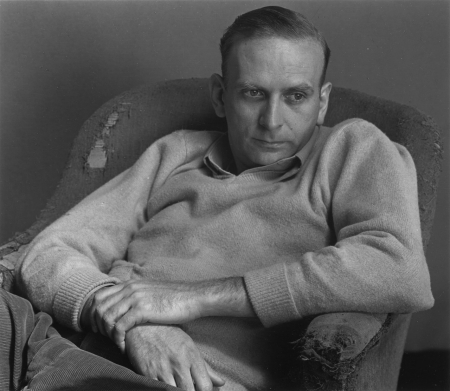Frederick Sommer in Context
INTRODUCTION

Edward Weston, Frederick Sommer, 1944 (No. 9), gelatin silver print. Courtesy Frederick & Frances Sommer Foundation
Frederick Sommer’s (1905–1999) peripatetic life and multifaceted work defy easy classification. He was born in Italy to German-speaking parents, grew up in Brazil, and spoke five languages fluently by the time he received his master’s degree in landscape architecture from Cornell University. In 1931, after being diagnosed with tuberculosis, he moved permanently to the United States with his American wife, Frances (1904–1999). The couple settled in 1935 in the small town of Prescott, Arizona, where Frances was a social worker. There, far from metropolitan cultural hubs, the two lived for over sixty years.[1]
During the early 1930s, Sommer turned to drawing and painting, pushing the limits of his earlier training in architectural draftsmanship and design.[2] He expanded his intellectual horizons by reading widely, and, despite Prescott’s remoteness, he also established friendships with pioneers and proponents of modern art in America, including such well-known figures as Edward Weston, Max Ernst, and Aaron Siskind. Over the course of the subsequent decades, Sommer experimented with a wide variety of media, producing significant bodies of drawings, collages, theoretical writings, and, above all, photographs, which were the most inventive part of his oeuvre from the late 1930s until the mid-1980s. Though he never belonged to any artistic movement, Sommer exhibited these works widely, showing them alongside such disparate artists as the surrealists and the f/64 group of California photographers known for sharp focus, precise compositions, and tonally lush prints.
The subjects of Sommer’s photographs are strikingly diverse. They range from disorienting landscapes and macabre aspects of the natural world to surreal arrangements of found objects and pure abstractions. Yet there is also a distinct vision that connects all his works. Sommer’s photographs show an abiding interest in form and a consistently startling approach to composition, texture, and scale. His writings reference the hidden structure that he saw all around him, the beauty of which he sought to reveal in his images. “As artists we are custodians of order,” Sommer wrote, “and in ordering a collection we also learn what it is.”[3]
Sommer’s deep desire to find order amid chaos led him to closely examine objects and sites that others found too quotidian, ugly, or insignificant to notice. Paradoxically, Sommer was dedicated to the traditional idea of art as a means of creating beauty even as his uncanny, enigmatic, spooky, and clever images expanded the idea of where beauty might be found.
In 1995, Sommer gave the National Gallery of Art a gift of 55 works.[4] Comprised of 33 photographs, 12 drawings, and 10 collages, it broadly represents Sommer’s career and is the basis for this introduction to his life and work. Additional images from the Gallery’s collection and from other museums and private collections have been included to place Sommer’s work in dialogue with the art of notable contemporaries who were his friends. Their work provided influences and sources of inspiration that Sommer acknowledged when he wrote, “All rare things should be lent away and I have borrowed very freely.”[5]
[1] Unless otherwise noted, the biographical information found throughout this web feature comes from Naomi Lyons and Jeremy Cox, eds., The Art of Frederick Sommer: Photography, Drawing, Collage (Prescott, AZ and New Haven, CT, 2005). A detailed online chronology of the Sommers' lives can be found on the website of the Frederick & Frances Sommer Foundation.
[2] Sommer’s father was a landscape architect, and Frederick had done architectural drafting for his father as early as age 11. See Philadelphia College of Art. Frederick Sommer (Philadelphia, PA. 1968). 5.
[3] Frederick Sommer, “General Aesthetics, Part III,” originally written in 1979, reprinted in Frederick Sommer, Sommer. Words (Tucson, AZ, 1984), 29.
[4]For a full list of works by Frederick Sommer in the collection of the National Gallery of Art, see here.
[5] Frederick Sommer, “Words not spent today / Buy smaller images tomorrow,” originally published in Aperture 10:4 (1962), reprinted in Sommer, Sommer. Words, 55.